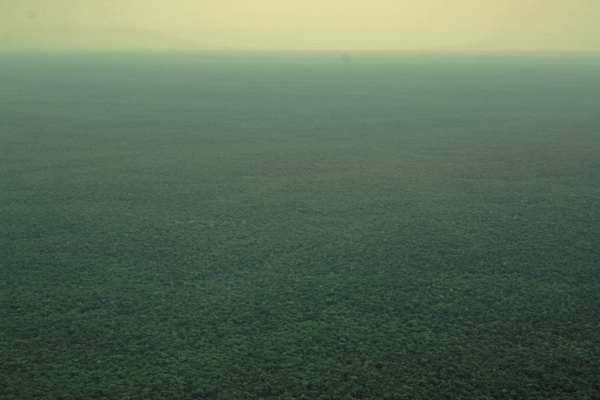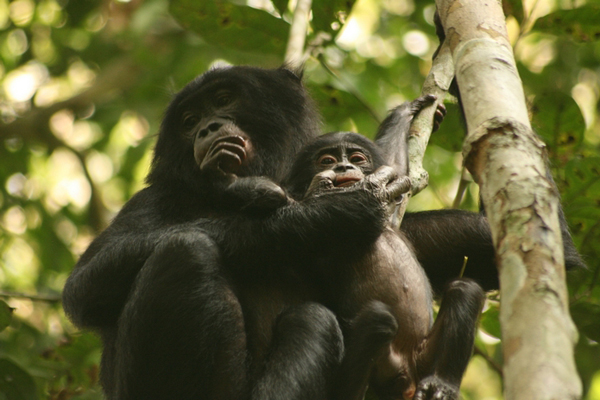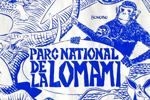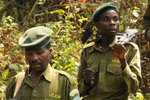The survival of primary forests depends on many overlapping interactions. Among these interactions include tropical gardeners, like the bonobo (Pan pansicus) in the Congo Basin, according to a new study in the Journal of Tropical Ecology. Bonobos are known as a keystone species, vital to the diversification and existence of their forests.
Bonobos, which are close relatives of the chimpanzee, service the forest by dispersing a multitude of seeds, thus maintaining rich, diverse forests. Other African tropical gardeners include monkeys, bats, birds, rodents and the African forest elephant. Recent research shows elephants disperse seeds approximately 57km from the parent tree, making the African elephant a powerfully effective “gardener.” But the new study shows that bonobos are also effective seed dispersers.
 Pan pansicus) in the Congo Basin. Photo by David Beaune/MPI”> Pan pansicus) in the Congo Basin. Photo by David Beaune/MPI”>A bonobo (Pan pansicus) in the Congo Basin. Photo by David Beaune/MPI |
Following bonobos over a period from September 2009 to July 2011, the scientists recorded the duration of the feeding session, the items consumed and the seeds processing (i.e. spitting, handling, swallowing) and found that bonobos are the second-largest fruigivore, after the elephant. The seeds passed by the bonobos have the proportion of fruit bearing trees germinating at a success rate of 97%.
“If Bonobos disappear from a forest, many plant species must be affected for reproductions (i.e. the seed dispersal provided by bonobos is lacking). In another experiment, we found that several trees dispersed by bonobos cannot reproduce without [Bonobo’s] seed dispersal,” said lead author David Beaune from the Max Planck Institute of Leipzig and the University of Burgundy. During the study, Beaune and his team surveyed 33-35 mature bonobos inhabiting a home range of 40 kilometers. Although bonobos eat a lot of fruit and seeds, their rich diet also includes leaves, stems, bark, gum, mushrooms, honey, soil, and even other animals.
 Pan pansicus). Photo by Terre Sauvage.” >
Pan pansicus). Photo by Terre Sauvage.” >
A bonobo infant (Pan pansicus). Photo by David Beaune/MPI

A view of the untouched forest of the Congo basin. Photo by David Beaune/MPI
“With corruption, poaching can continue easily. Only an anti-corruption politic tolerating zero poaching would help the bonobo and all the animal victims of the bushmeat traffic,” Beaune told mongabay.com. “Education is also a key. Now we can explain that protecting animal species is also protecting the entire forest. Today many kids in Africa have never met an elephant, bonobo and other creatures but I know that many of them are eager to protect them and are proud of their national species.”
Hadrian Vanthomme who studied the overall effects of the bushmeat trade adds, “When hunters remove big animals, they remove at the same time the ecological functions of the animals. So basically, we expect that if a guild of animals implied in seed dispersal of a plant is removed, the regeneration of this plant species will be compromised.”

Deforestation in the Congo basin. Photo by David Beaune/MPI
 Pan pansicus). Photo by Terre Sauvage.” >
Pan pansicus). Photo by Terre Sauvage.” >
A bonobo mom and baby (Pan pansicus). Photo by David Beaune/MPI
 Pan pansicus) enjoys lunch. Photo by Terre Sauvage.” >
Pan pansicus) enjoys lunch. Photo by Terre Sauvage.” >
A bonobo (Pan pansicus) enjoys lunch. Photo by David Beaune/MPI
Citations:
- David Beaune, François Bretagnolle, Loïc Bollache, Chloé Bourson, Gottfried Hohmann and Barbara Fruth (2013). Ecological services performed by the bonobo (Pan paniscus): seed dispersal effectiveness in tropical forest. Journal of Tropical Ecology, 29, pp 367-380 doi:10.1017/S0266467413000515
Related articles
28 percent of potential bonobo habitat remains suitable

(11/27/2013) Only 27.5 percent of potential bonobo habitat is still suitable for the African great ape, according to the most comprehensive study of species’ range yet appearing in Biodiversity Conservation. ‘Bonobos are only found in lowland rainforest south of the sweeping arch of the Congo River, west of the Lualaba River, and north of the Kasai River,’ lead author Jena Hickey with Cornell told mongabay.com. ‘Our model identified 28 percent of that range as suitable for bonobos. This species of ape could use much more of its range if it weren’t for the habitat loss and forest fragmentation that gives poachers easier access to illegally hunt bonobos.’
Remarkable new monkey discovered in remote Congo rainforest

(09/12/2012) In a massive, wildlife-rich, and largely unexplored rainforest of the Democratic Republic of the Congo (DRC), researchers have made an astounding discovery: a new monkey species, known to locals as the ‘lesula’. The new primate, which is described in a paper in the open access PLoS ONE journal, was first noticed by scientist and explorer, John Hart, in 2007. John, along with his wife Terese, run the TL2 project, so named for its aim to create a park within three river systems: the Tshuapa, Lomami and the Lualaba (i.e. TL2), a region home to bonobos, okapi, forest elephants, Congo peacock, as well as the newly-described lesula.
Innovative conservation: bandanas to promote new park in the Congo

(07/16/2012) American artist, Roger Peet—a member of the art cooperative, Justseeds, and known for his print images of vanishing species—is headed off to the Democratic Republic of the Congo (DRC) to help survey a new protected area, Lomami National Park. With him, he’ll be bringing 400 bandanas sporting beautifully-crafted images of the park’s endangered fauna. Peet hopes the bandanas, which he’ll be handing out freely to locals, will not only create support and awareness for the fledgling park, but also help local people recognize threatened species.
Without data, fate of great apes unknown

(03/12/2012) Our closest nonhuman relatives, the great apes, are in mortal danger. Every one of the six great ape species is endangered, and without more effective conservation measures, they may be extinct in the wild within a human generation. The four African great ape species (bonobos, chimpanzees and two species of gorilla) inhabit a broad swath of land across the middle of Africa, and two species of orangutans live in rainforests on the islands of Borneo and Sumatra in Southeast Asia.
Unsung heroes: the life of a wildlife ranger in the Congo

(11/01/2011) The effort to save wildlife from destruction worldwide has many heroes. Some receive accolades for their work, but others live in obscurity, doing good—sometimes even dangerous—work everyday with little recognition. These are not scientists or big-name conservationists, but wildlife rangers, NGO staff members, and low level officials. One of these conservation heroes is Bunda Bokitsi, chief guard of the Etate Patrol Post for Salonga National Park in the Democratic Republic of the Congo. In a nation known for a prolonged civil war, desperate poverty, and corruption—as well as an astounding natural heritage—Bunda Bokitsi works everyday to secure Salonga National Park from poachers, bushmeat hunters, and trappers.